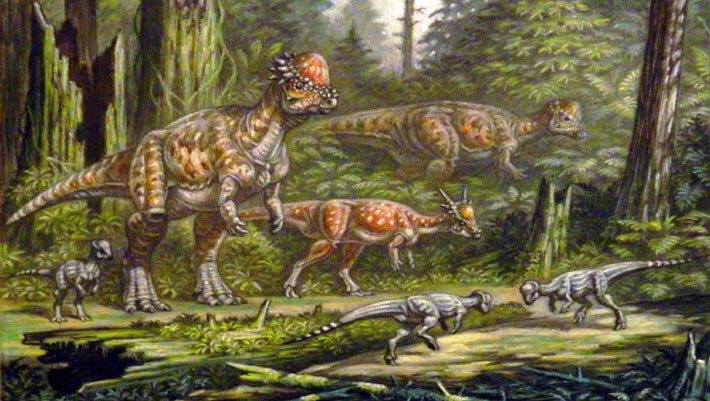Paleontologists have unearthed the fossilized remains of two new small-bodied pachycephalosaurines: one in the Dinosaur Park Formation of Alberta and the other in the Hell Creek Formation of Montana.

Sphaerotholus buchholtzae (smaller species) fighting below larger pachycephalosaurs, the Hell Creek Formation, Montana, the United States. Image credit: ABelov2014 / CC BY-SA 3.0 Deed.
One of the new dinosaur species, named Sphaerotholus lyonsi, lived 75 million years ago in what is now Canada.
The other, Sphaerotholus triregnum, lived in the United States approximately 67 million years ago.
Both species belong to Sphaerotholus, a small dinosaur genus in the subfamily Pachycephalosaurinae within the family Pachycephalosauridae.
“Despite a poor representation in the fossil record, with their thickened frontoparietal domes and hypothesized head-butting behavior, Pachycephalosauridae are some of the most iconic dinosaurs,” said lead author Dr. Cary Woodruff, a paleontologist with the Phillip & Patricia Frost Museum of Science and the Museum of the Rockies, and his colleagues.
“While the true function of their unusual cranial domes continues to be debated, considerable research has focused on their ontogeny and diversity.”
“This work has been complicated by an unusual fossil record that is dominated by disarticulated cranial remains, with associated skeletons being exceptionally rare.”
“This pattern is likely to be the result of their small body size and taphonomic biases against the preservation and recovery of their delicate skeletons, and the robust and diagnostic nature of the bones that comprise their cranial domes.”

Holotype left squamosal of Sphaerotholus triregnum. Scale bars represent 1 cm. Image credit: Woodruff et al., doi: 10.1002/spp2.1535.
Sphaerotholus lyonsi and Sphaerotholus triregnum are each represented by an isolated squamosal, a skull bone found in most reptiles, amphibians, and birds.
“The holotype of Sphaerotholus lyonsi was collected on the north side of the Red Deer River, in the northeast region of Dinosaur Provincial Park, Alberta, Canada,” the researchers said.
“The holotype of Sphaerotholus triregnum was collected from the lower half of the Hell Creek Formation, around 45 km southwest of the town of Jordan in Garfield County, Montana, the United States.”
“The specimen was collected from the same channel complex and no more than 500 m from the holotype locality of the dromaeosaurid Acheroraptor temertyorum.”
“These two new specimens are approximately the same size as squamosals of Sphaerotholus buchholtzae, and possess several overlapping morphologies with the Sphaerotholus genus.”
These new species fill morphological gaps in the pachycephalosaurid fossil record and show that forms with multiple node rows were more diverse than previously appreciated.
“The description of two new small-bodied pachycephalosaurid species in the genus Sphaerotholus provides additional insights into the evolution of North American pachycephalosaurids,” the scientists said.
“Although aspects of pachycephalosaurid phylogeny remain unresolved and contentious, due in part due to the incomplete nature of their remains, this analysis is the first to identify possible evolutionary events in two distinct lineages of small-bodied pachycephalosaurine in North America.”

Holotype right squamosal of Sphaerotholus lyonsi. Scale bars represent 1 cm. Image credit: Woodruff et al., doi: 10.1002/spp2.1535.
“Sphaerotholus lyonsi and Sphaerotholus triregnum provide evidence that:
(i) small-bodied dinosaur species are still to be discovered in well-sampled formations;
(ii) pachycephalosaurid diversity in the Dinosaur Park and Hell Creek formations was richer than previously thought, and the diversity of North American pachycephalosaurids is likely to continue to increase;
(iii) species with ornamentation consisting of multiple node rows are in fact more numerous and diverse across Pachycephalosauridae than previously known;
and (iv) North American pachycephalosaurids appear to have remained relatively diverse throughout the Maastrichtian age, which has consequences for our understanding of dinosaur evolutionary and diversity dynamics throughout the latest Cretaceous of North America leading up to the end-Cretaceous extinction event.”
The findings appear in the journal Papers in Palaeontology.
_____
D. Cary Woodruff et al. 2023. Two new species of small-bodied pachycephalosaurine (Dinosauria, Marginocephalia) from the uppermost Cretaceous of North America suggest hidden diversity in well-sampled formations. Papers in Palaeontology 9 (6): e1535; doi: 10.1002/spp2.1535

